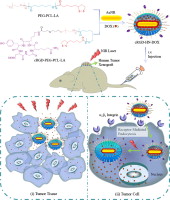Zhiyuan Zhonga,*(钟志远)
a Biomedical Polymers Laboratory and Jiangsu Key Laboratory of Advanced Functional Polymer Design and Application, College of Chemistry, Chemical Engineering and Materials Science, Soochow University, Suzhou 215123, PR China
b Jiangsu Key Laboratory for Carbon-Based Functional Materials & Devices, Institute of Functional Nano & Soft Materials (FUNSOM), Soochow University, Suzhou 215123, PR China
Journal of Controlled Release 2014, 195, 63–71
cRGD-directed, NIR-responsive and robust AuNR/PEG–PCL hybrid nanoparticles (cRGD-HNs) were designed and developed for targeted chemotherapy of human glioma xenografts in mice. As expected, cRGD-HNs had excellent colloidal stability. The in vitro release studies showed that drug release from DOX-loaded cRGD-HNs (cRGD-HN-DOX) was minimal under physiological conditions but markedly accelerated upon NIR irradiation at a low power density of 0.2 W/cm2, due to photothermally induced phase transition of PCL regime. MTT assays showed that the antitumor activity of cRGD-HN-DOX in αvβ3 integrin over-expressed human glioblastoma U87MG cells was greatly boosted by mild NIR irradiation, which was significantly more potent than non-targeting HN-DOX counterpart under otherwise the same conditions and was comparable or superior to free DOX, supporting receptor-mediated endocytosis mechanism. The in vivo pharmacokinetics studies showed that cRGD-HN-DOX had much longer circulation time than free DOX. The in vivo imaging and biodistribution studies revealed that cRGD-HN-DOX could actively target human U87MG glioma xenograft in nude mice. The therapeutic studies in human U87MG glioma xenografts exhibited that cRGD-HN-DOX in combination with NIR irradiation completely inhibited tumor growth and possessed much lower side effects than free DOX. The Kaplan–Meier survival curves showed that all mice treated with cRGD-HN-DOX plus NIR irradiation survived over an experimental period of 48 days while control groups treated with PBS, cRGD-HN-DOX, cRGD-HNs with NIR irradiation, free DOX, or HN-DOX with NIR irradiation (non-targeting control) had short life spans of 15–40 days. Ligand-directed AuNR/PEG–PCL hybrid nanoparticles with evident tumor-targetability as well as superior spatiotemporal and rate control over drug release have emerged as an appealing platform for cancer chemotherapy in vivo.

链接:
//www.sciencedirect.com/science/article/pii/S0168365914005653#